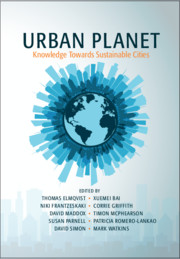The title of this chapter is taken from a 2006 French film directed by Alain Resnais. Although it doesn’t relate directly to the urban, per se, it speaks very clearly to a set of concerns that have been on my mind since I was a teen. I grew up yo-yo-ing between two very different cities, Accra and London, and therefore between two very different urban cultures.
Through a child’s eyes, Accra was dense and close. Warm. Loud. Spontaneous. Anything could – and frequently did – happen. In the 1970s, it was fairly common to see a donkey trotting along, sandwiched between cars. Working traffic lights were few and far between. Kiosks selling bananas and oranges sat comfortably in the shade of suburban mansions. At lunchtime, municipal workers were as likely to sleep on the pavement as to walk on it. The city was gossipy, intimate, and indifferent. Peoples’ lives unfolded in and around the city, almost in spite of it. A traffic jam was an opportunity to sell something – live puppies, toilet paper, sugarcane. A street could host a funeral or a carnival, depending on the mood. Church began at dusk and lasted all night. Passersby, anything goes.
London was different, and oppressively so. Quiet. Fast. Apart. Roads were for cars, not donkeys. People shopped in shops that stuck rigidly to opening hours. No woman ever settled herself down by the side of the road to sell bottles of warm Coke or powdered milk. Nothing ever seemed to happen. The difference was expressed not only physically – in the scale, form, and shape of buildings – but also (and perhaps more interestingly) in peoples’ behavior, not just towards one another, but towards the city itself. Long before CCTVs sprang up on every corner, London’s buildings maintained a watchful, beady eye, expressed clearly in signs and admonishments: No Smoking. Do Not Walk on the Grass. Residents Only. No Dogs. Citizen, know thy place.
Of course, these generalizations are a little predictable. But in my second year of architecture school, suddenly the childish observations began to deepen and crystallize: cities are shaped as much by how we behave in them as by their tangible fabric. Programs, which dictate – to a certain extent – what we do in buildings and how we structure and form them – don’t hold quite as much sway in Accra, where adaptability, improvization, and an ability to just “go with the flow” are of more use to your average citizen than a well-mannered observance of the rules. Accra had attitude, in spades. London did too, but borne of arrogant confidence, not inventive contingency.
A decade ago, Richard Sennett wrote, “The cities everyone wants to live in should be clean and safe, possess efficient public services, be supported by a dynamic economy, provide cultural stimulation and also do their best to heal society’s division of race, class and ethnicity. These are not the cities we live in.”Footnote 1
How true. I live in Johannesburg, possibly one of the least “healed” cities on the planet. The divisions of race, class, and ethnicity are alive and well in Jo’burg, shaping not just the physical city but our mental image of it as well. This is a city of nothing but difference, relentlessly and continuously expressed. Here, Africa – whatever that means – and Europe exist cheek by jowl, simultaneously codependent and determinedly apart. Opportunities for the myriad citizens of Johannesburg to spontaneously “come together” are few and far between. The FIFA World Cup; Mandela’s passing; election day … these are solitary moments where South Africans of all backgrounds self-consciously rub shoulders, thrilled on the one hand to have “discovered” a shared sense of their public selves, but on the other, equally worried that a single false comment or a sideways glance will “set it all off.” The recent furor unleashed by the South African bigot Penny Sparrow illustrates this beautifully. Her Facebook comment,Footnote 2 which compared black South Africans to monkeys, hits the nail on the head, though it’s safe to assume not in the way she intended: private fears in public spaces. Sparrow has been expelled from the Democratic Alliance political party and is said to have immigrated to Australia. Yet for all the hue and cry, there’s an uncomfortable truth lying at the heart of the matter that few of us acknowledge: here in South Africa, there is – as yet – no common understanding around what it means to be urban. To be public. To share the city. To be together. Bourgeois values, lifted straight from nineteenth-century Europe and transplanted onto cultures that already had their own value system(s), make blanket, blind assumptions about all manner of behaviors, no pun intended. But urban cultures are formed, not imposed. They emerge out of shared experiences and shared histories, however contested. It takes a mature society to form not only the consensus around which public behavior – public “togetherness”– is molded but also the mechanisms by which it changes, develops, accommodates, renews itself. Sennett argues that cooperation is a skill.Footnote 3 It is learned, practiced, finessed. A healthy, tolerant, and resilient urban culture may also be viewed as a skill to which attention, effort, and energy must be paid. It’s an aspect of sustainability we seldom discuss: to be sustainable is not only to refer to ecology and the environment, it includes ideas about equity and etiquette, too. Perhaps it’s time we started practicing how to be together, learning how to fuse our often-contradictory attitudes about public and private together without friction and suspicion; understanding that these are not “universal” values, but are culturally determined and specific. It’s time for us to learn the basic ropes of urban etiquette, trying – and, yes, failing – and trying again, instead of blindly assuming that we somehow already know.

Figure 45.1 Makola Market, Accra, midday. Man carrying bathing sponges for sale.




